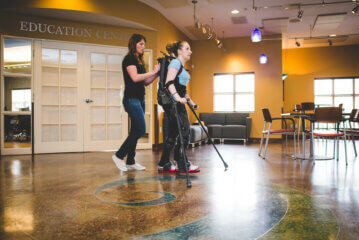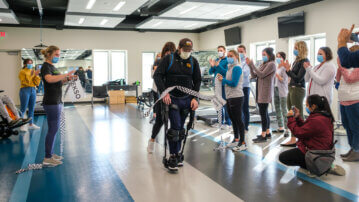When Tyler Bruck stands from a chair on the morning of November 17, 2020, the action receives a shower of applause. Normally packed to the walls with rehabilitation technology, today the therapy lab is crowded with therapists, team members and an assortment of well-wishers.
He stands some thirty feet removed from a finish line. Snug over his shoulders and fitted to his legs is a complex robotic suit. In moments, the same servos and whirring electric motors that stood Bruck upright will proceed to help him stride to the goal. Here — on this day with these final steps — the 28-year-old spinal cord injury survivor commands all attention.
This is the Ekso, a wearable exoskeleton QLI has employed for nearly eight years in its intensive gait-training program. And this morning, Bruck proudly guides the device across a distinct milestone, one earned helping countless men and women relearn how to walk after injury.
One million lifetime steps.
Using no crutches or handheld assistive devices, Bruck strides forward.
Gait training didn’t always look this way.
Just a decade ago, walking-focused robotic technology and specialized biomechanics laboratories were intangible notions, future-tech that seemed years out of reach. To provide adequate gait practice in technology’s place, rehabilitation facilities needed extraordinary effort and overwhelming manpower.
“Historically in our profession,” says Brad Dexter, one of QLI’s Coordinators of Therapy Services, “it took two or three people to provide bodyweight support: One person behind the client hoping to shift and stabilize weight, another person to physically move the leg for the client and blocking the knee so the leg wouldn’t collapse, and then a third person behind the other two ready with a chair if the client needed to sit.”
Requirements like these could limit the scope and scale of gait-related therapy. Whether in over-ground situations, in aquatic environments, or using a treadmill and bodyweight support, the sheer magnitude of necessary effort threatened to exhaust the therapists involved or, worse, placed both clinician and client at an increased risk for injury.
And yet, Dexter explains, gait training was still about tallying quality repetitions. Repetition mattered, but it needed to be relevant enough in practice and voluminous enough in quantity to promote neuroplasticity—the rebuilding of neural pathways, resulting in motor recovery.
“It all comes back to how we learn and how we, as clinicians, maximize that learning process. Then we can focus on how to make this a more efficient, safer, higher-repetition activity,” he says.
Enter Ekso Bionics.

With the support of the device, individuals suffering from paralysis could stand — even walk.
By 2013, QLI’s clinical leaders began incorporating a diverse arsenal of rehabilitation technology into its gait training program. The team investigated a number of hydraulically powered devices that might supplement the program’s growth.
Time and again, the Ekso impressed, offering a variety of unique benefits.
“Therapists can break down a person’s gait into, essentially, two phases,” Dexter explains, “a stance phase and a swing phase.
“What we can do with the Ekso, particularly for someone whose gait is impaired, is design entire phases of that gait training process. The Ekso moves the client’s leg the way we want it to move, and refines, or even strengthens, that movement.”
On top of its unprecedented usefulness as a gait mechanics augmentation, the Ekso’s hardware presented an additional noteworthy benefit — the opportunity for repetition in extraordinary volume. Where, previously, a manual gait training session may have performed as few as 25 steps, an hour-long appointment with the Ekso could deliver 1000 or more.
In layman’s terms — practice makes perfect.
Incorporated into QLI’s physical therapy program, the Ekso aided therapists in instantly shattering ceilings — redefining progress and supercharging results.
In use, the suit offers variable levels of assistance but requires the control of a therapist — hands-on at the back-mounted control panel or at close standby as users walk with nominal independence.
Creative application and intentionality are what, as Dexter explains, make the device go.
“You can throw anyone into any device and go through the motions,” he says, “but if you don’t have the right therapist individualizing the program, being intentional, critically thinking through what the next goal might be for the person beyond the Ekso, the steps you take don’t lead anywhere.”
It’s through QLI’s clinical lens that the Ekso’s unique potential is teased to the surface. QLI serves a range of diagnoses—not only spinal cord injuries, but traumatic brain injuries and strokes as well. For severe cases, walking may not be an immediate clinical goal. Yet the Ekso still offers tremendous utility.
Boosts to cardiovascular health, for instance, can be crucial for individuals otherwise spending hours or days seated in a wheelchair. Decreases in spasticity—a phenomenon in which impaired muscles become rigid in response to gentle, passive movement—lead to global improvements in musculoskeletal health and range of motion.

The Ekso can’t guarantee independent ambulation. But it represents a paradigm shift in the research and technology available to maximize potential. Likewise, more than eight years after it first arrived at QLI, the Ekso is just one centerpiece among many within QLI’s Daniel and Lynda Dietrich Center for Physical Rehabilitation—a cutting-edge robotics lab home to numerous applications singularly focused on restoring optimal motion.
Tyler’s strides are calm, easy. Forming a tunnel at his sides, the onlookers cheer him toward the checkered stripe, at which point he will have carried the bionic device to its millionth step, a milestone few other facilities across the country have achieved.
From the placid concentration on Bruck’s face, it’s clear this machine’s lifetime step count isn’t his priority. Using these steps to walk again—truly walk, without assistance—is.
Bruck reaches the finish line. It snaps easily across his stomach. And with a one-hundred-degree pivot, he adds a handful of extra steps to the count, making his way back to the chair.
“This is my last time in the Ekso,” he says. There’s a sense of relief in his voice as his therapist unclasps the robotic boots from his calves for the last time. In the weeks that follow, he’ll train with gradually reduced levels of assistance. At a point sooner rather than later, he’ll walk again under his own power.
It means he’s getting better after one injury changed his life. It means progress in real time.
“I don’t need the Ekso anymore. So, when you think about it, today is really my day.”
Categories: Adaptive Technology, Brain Injury, Gait Training, Neuroplasticity, QLI Magazine, Spinal Cord Injury


